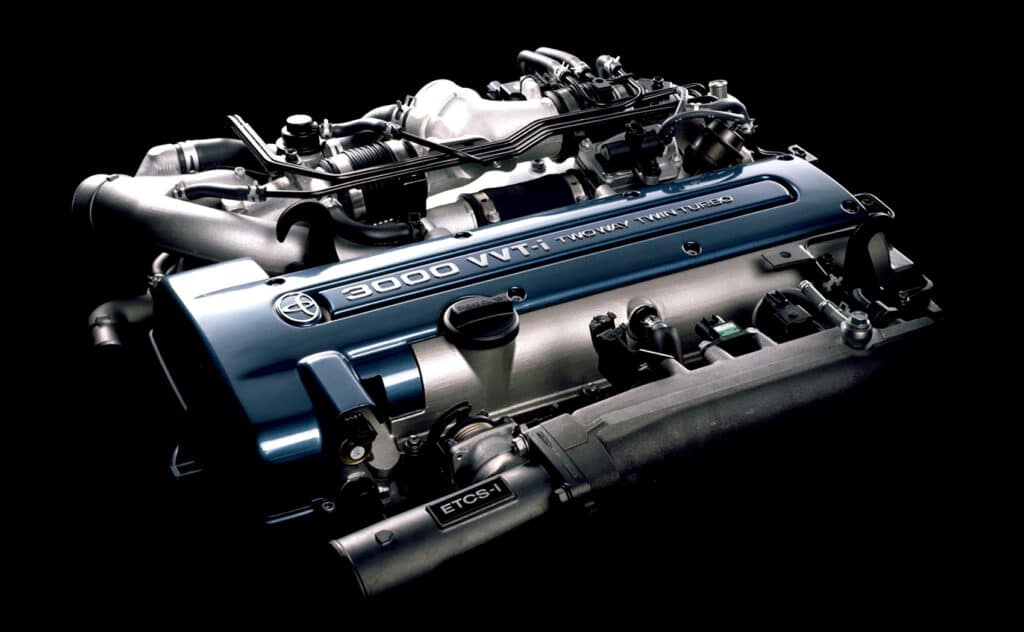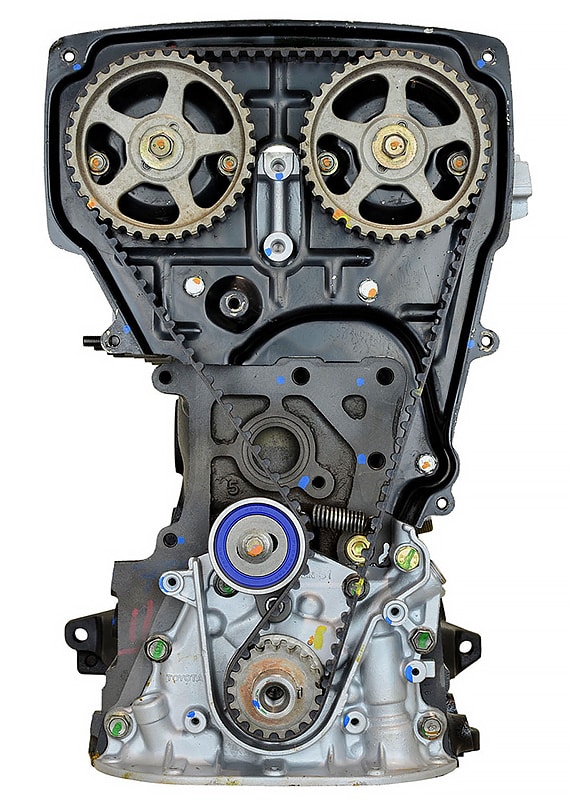Toyota may not be the first automaker that comes to mind when discussing performance engines. However, over the years, the manufacturer has produced some legendary cars with equally iconic powerplants.
While some of these engines haven’t officially been in production for decades, it’s still possible to purchase them.
We are of course talking about crate engines; not only are they available in stock form, but you can even buy fully built high-output Toyota crate engines that pump out several times more power than the manufacturer ever intended.
While there are Toyota diesel crate engines available, we’ve focused solely on the gasoline models here.
It’s hard to predict how much Toyota crate engines cost since there are so many variations. In this article, we’ll take a closer look at specs and power, so you can decide whether they should be on your consideration list for your next build.
What Is a Crate Engine? Why You Should Buy One?

Crate engines are fully assembled powerplants offered in a package, simplifying the engine replacement or upgrade process.
Choosing a crate engine ensures a reliable and potent solution without the intricacies of individual component selection.
Crate engines typically package a popular powerplant for enthusiasts seeking a reliable and powerful solution for their projects.
Best Toyota Crate Engines
Toyota’s lineup boasts a diverse range of crate engines catering to various preferences and applications.
From the iconic 2JZ and 1JZ motors to the innovative 2ZZ-GE, each engine brings unique characteristics to the table.
G16E-GTS Inline-3

That’s right, it’s possible to find a brand-new G16E-GTS for sale.
This is the 257-300 hp turbocharged 3-cylinder 1.6L unit that’s found under the hood of the GR Yaris and GR Corolla, and it’s already become very popular among tuners and performance aficionados.
In Europe, there are specialty importers that offer both long and short-block versions of the G16E-GTS straight from Toyota Japan — just don’t expect to get your hands on one for cheap.
Another option is to buy a refurbished engine from one of the tuning shops, but again, prepare to open your wallet.
22RE Inline-4

The Toyota R engine family was fitted in both their utility vehicles, such as the Hilux and 4Runner, and performance models like the Celica, and it was in production from 1953 through 1997.
The Toyota 22R 2-valve, SOHC 2.4L engine produced between 97 and 109 hp, and after being reworked in 1985, power was increased to 113 hp.
It’s easy to find a 22R engine for sale, as a quick Google search will return plenty of results of both refurbished and completely remanufactured examples that offer performance and durability beyond Toyota’s original specifications.
That tells you everything you need to know, as these engines are famous for their durability.
Yota1 sells these Toyota 4Runner crate engines in Stage 3 configuration with 145 hp and 210 lb-ft of torque, which is more than the turbocharged 22R-TE produced in stock form (135 hp).
2JZ-GTE Inline-6

The Toyota 2JZ-GTE found its fame alongside the 1993-1998 Supra Turbo.
It’s by far the most famous and capable of all the Toyota performance crate engines, producing 320 hp and 315 lb-ft of torque in stock form.
Those numbers can easily be improved upon with a handful of mods, and the cast-iron block is practically indestructible.
It’s possible to buy a 2,500+ hp long block 2JZ crate engine if you wish, although, at that point, you certainly shouldn’t expect it to offer the same reliability.
If you’re satisfied with less power, buying a 2JZ with 750-ish hp will give you the best of both worlds and according to Jesse in The Fast and the Furious, it will decimate all.
1JZ-GTE Inline-6

The 1JZ is the 2JZ’s smaller sibling, and while it might not be as capable in full-on race-spec, it’s still one of the best Toyota crate engines money can buy.
Best known for powering 4-door JDM cars such as the 1996-2001 Chaser, the 1JZ-GTE produces 280 hp and 280 lb-ft of torque in stock form, but those numbers can be pumped up without much effort.
This is probably a better option than the 2JZ if you’re planning to build a somewhat compact car, as the 2.5-liter is physically smaller than the 2JZ, and it also comes with a single turbo and VVT-i.
4A-GE Inline-4

While the 4A-GE may not be one of the high-output crate engines in stock form, it’s still a renowned engine that’s easily tuned, and Yamaha designed it for performance using wide valve angles.
It was fitted in a variety of Toyota drift cars and performance cars in general, most notably in the AE86 Corolla and the 1st-gen MR2 — some of the best JDM cars of all time.
The early versions of the engine sold on the American market produced 112 hp, but later versions saw this figure pumped up to 123 hp.
Remanufactured 4A-GE crate engines are readily available, and it’s even possible to buy 700+ hp turbocharged versions — not bad for a tiny 1.6L first introduced in 1983.
3S-GTE Inline-4

The 3S-GTE is based on the 3S-GE but features under-piston oil squirters, a reduced compression ratio, and an air-to-air intercooler since it has a turbocharger.
First introduced in 1986, Toyota kept making the 3S-GTE until 2007, spanning multiple generations. It produced between 182 and 256 hp, depending on the generation.
The 2nd-gen MR2 is probably its most famous home, but it was also used in the Celica GT-Four/All-Trac and the Caldina.
These crate engines are available in both standard and tuned form, and most of them seem to be based on the final 4.5 version.
7M-GTE Inline-6

If you have an Mk3 Supra, or some other old RWD Toyota, you might want to consider the 7M-GTE Toyota crate engine.
A 7M-GTE long block crate engine in perfect shape costs a lot less than a worn-out 2JZ.
While it’s not as celebrated as the 1JZ and 2JZ, it’s still highly capable in tuned form and delivered 232 hp and 240 lb-ft of torque stock, which made it the most powerful Toyota engine of its era.
2ZZ-GE Inline-4

The 2ZZ-GE can be found in the 2000-2005 Celica GT-S where it produced 180 hp and 133 lb-ft of torque.
The 2ZZ-GE features a VVTL-i valvetrain as a response to Honda’s famous VTEC and i-VTEC systems. Alas, it never gained the same fame, as it’s not as capable as the Honda K-series it remains a bit overlooked by the aftermarket.
However, it’s still a great unit, and a popular swap option among MR2 Spyder owners, as it came with the 140 hp 1ZZ engine.
Several companies offer 2ZZ Toyota crate engines, and you can choose between a completely stock or fully-built unit — or something in between.
1GR-FE V6

As far as Toyota V6 engines go, it’s hard to beat the 1GR-FE 4.0 crate engines when it comes to reliability.
The 1GR-FE was fitted in Toyota’s utility vehicle lineup and is found in models such as the 4Runner, Tacoma, Hilux, Land Cruiser, and Tacoma.
It produces 236 to 285 hp in stock form, but thanks to its partially forged rotating assembly, it can handle more.
There was even a bolt-on TRD supercharger kit available for it, so one of these crate engines can offer plenty of power and longevity.
2UZFE V8

The Toyota 2UZ-FE 4.7L V8 debuted in the 1998 Land Cruiser, and power output varies from 228 to 271 hp, depending on the year and model.
You can find these 4.7L crate engines built to provide both power and reliability, perfect if you’re creating a powerful everyday truck or an overland vehicle.
The 2UZ is known to keep running for 250,000+ miles, experiencing very few if any, major issues along the way, making it one of the most reliable Toyota engines.
Summing Up
Toyota crate engines provide a spectrum of options for enthusiasts seeking reliable and powerful solutions.
From the legendary 2JZ-GTE to the innovative 2ZZ-GE, these engines represent the pinnacle of Toyota’s engineering.
Whether you’re looking for JDM excellence, forced induction brilliance, or V8 muscle, there are Toyota crate engines available in a diverse range of options to power your automotive dreams.
Which one of these crate engines would you pick? Let us know by leaving a comment below.
If you found this list useful, share it with a friend! We appreciate your support.


1 comment
I have a 1990 4×4 Toyota pickup with a v6 factory engine and would like to install a v6 crate engine. Would the 1GR-FV6 fit and bolt to the 1990 bell housing without an adaptor? Would the computer need to be upgraded? If anyone knows, please tell me!